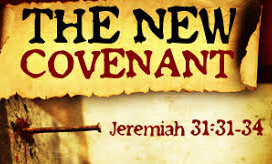Bible Notes... |
What is the New Covenant? |
by Rick Howard |

|
|
Text: Jeremiah 31:31-34 Jeremiah offers the prophecy of it, but when is it? and who participates in it? The New (kainos) Covenant is
a good example of the "already/not yet" principle - it is a
present reality but has a more complete future application. As with so
many subjects, it finds its initial application at Christ's first coming
and then its ultimate expression with His return and kingdom age. It is
also a good example of the "new but not new" principle - new
to a large degree but not to the point of having no previous foundational
existence.
Christ Himself declared to His new church in the upper room at the institution of the Lord's Supper - a church ordinance - with the words "This cup is the new covenant in My blood" (Luke 22:20). Paul repeated these same words to the church in Corinth (1 Corinthians 11:25). Paul purposely applies Jeremiah's
words (Jeremiah 31:33) to the Corinthian church (2 Corinthians 3:3). Thus
we likewise speak of a "regenerated" membership, a public testimony
of "knowing the LORD." The Hebrew writer quotes the entirety of the original prophecy of Jeremiah 31:31-34 in Hebrews 8:8-12, and both declare this new covenant is "not according to the covenant that I made with their fathers in the day when I took them by the hand to lead them out of the land of Egypt…..". Although a covenant was indeed
made with the "fathers" (i. e., with Abraham, Isaac & Jacob)
it should be noted that this 'New Covenant' is different than the Mosaic-Sinai
covenant (compare Deuteronomy 5:2,3). The "new" covenant was
made with the "wheat" of Israel & Judah (Matthew 3:12),
by Jesus offering Himself to them as a similar grain of wheat to be pushed
into the soil to die for them. Gentiles would later be grafted in among
them under the arrangement of this 'New Covenant' (Romans 11:17). The 'New Covenant' is said to be the "everlasting covenant" in Hebrews 13:20; a covenant ratified by the blood of Christ, linking it to the Abrahamic Covenant which is also referred to as the "everlasting covenant" (Genesis 17:7). The Davidic promise, or covenant (also said to be "everlasting") is likewise embedded within the framework of the Abrahamic (2 Samuel 7:12-16; 2 Samuel 23:5; Psalm 89:20-37; Luke 1:30-33). Paul reiterated to the brethren in the church at Rome that God was, in such moves, seeking to "confirm promises made to the fathers" (Romans 15:8). Now, under the arrangement of
this New Covenant, an individual must have a changed heart and have experienced
forgiveness of their sins (Jeremiah 31:34). In the Mosaic covenant, one
could be a citizen of the nation of Israel and circumcised and Law keeper
but still be unregenerate and had to be told "know the LORD"
but a person must already "know the LORD" before they can be
under this new covenant (Genesis
17:7). "Descendants" here include His spiritual "seed"
(Galatians 3:29). Such is seen when we compare 1 Peter 2:10 & Jeremiah
31:33. The future application of the new covenant will be to a "born in one day" regenerated nation (Isaiah 66:8) when God will "graft them in again" (Romans 11:24). This is the "everlasting covenant" future (Isaiah 61:8; Jeremiah 32:40; Ezekiel 16:60; Ezekiel 37:26). The Law (Mosaic) covenant was "added" to the already existing Abrahamic about 500 years later (Galatians 3:19). How long was it to be added? "till the Seed should come" (Galatians 3:19). That "Seed" (Jesus) then "nailed it to the cross" (Colossians 2:14). And in doing so, the "first" (Mosaic) became "obsolete" (Hebrews 8:13). This truth is verified by the apostle Paul (2 Corinthians 3:7,11,13,14). The "everlasting covenant" is "what remains" (2 Corinthians 3:11). "The eternal purpose" of "the everlasting covenant" is through Christ the Seed (Ephesians 3:11). The "everlasting covenant," given first to Abraham, continues through "that which remains" (2 Corinthians 3:11) with "enhancements" (kainos) of:
Christ's death, resurrection
and return assures it. To receive the Messiah fully is to receive the
new covenant (Isaiah 42:1-6). He is the Person of the covenant. He is
the "Elect One" (Isaiah 42:1) of the "elect remnant"
(Romans 11:5-7). Those operating in "spirit and truth" are operating
under the new covenant. |